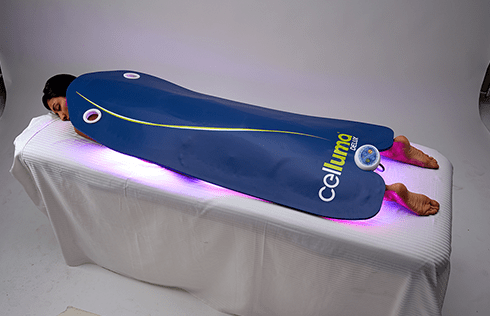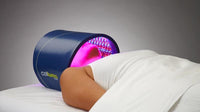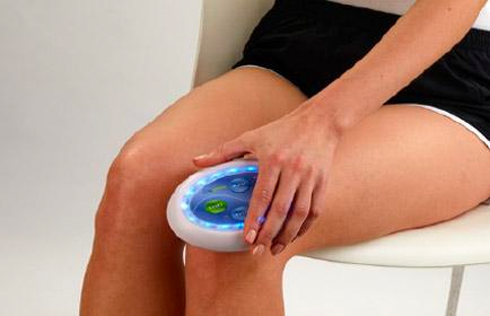Green LED Light Therapy: How Effective is It?

In LED light therapy, depth of penetration is determined by wavelength. The longer the wavelength of light energy, the deeper the light reaches into the tissue, within a well-defined range. Thus, the better the treatment results for the skin.
Green Light Therapy Devices: Wavelengths Just Too Short
In recent clinical studies on hyperpigmentation, near-infrared light energy was demonstrated to reduce the appearance of hyperpigmentation as it easily reaches the dermis, down-regulating hyperactive dermal melanocytes without side effects.
Green light therapy wavelengths are simply too short to reach the melanocytes in the dermal layer of the skin.What the Research Says
These finding do not negate the fact that some skin care professionals can achieve favorable anecdotal results using green light therapy to treat hyperpigmentation. However, this modality of treatment is not supported by robust, peer-reviewed and published clinical data.
Red and near-infrared wavelengths of light energy are much longer than green light therapy and therefor more effective in reaching the target tissue in the treatment of hyperpigmentation.
Know the Science behind Skin Health
As the manufacturer of the most medically credentialed and most awarded LED light therapy device in medical aesthetics and chronic pain management, we are committed to understanding the science of low-level light therapy and sharing its benefits though science based-education.
Common Question Regarding Green Light Therapy
We are frequently asked about the effect of green light therapy for hyperpigmentation. The fact is that very little has been published on the use of green wavelengths in photobiomodulation (PBM).
It is therefore not clinically relevant to use green light since we still don’t have evidence-based proof to validate its efficacy.
The Celluma Diffference
Specific to our LED light therapy machines, Celluma emits three discreet wavelengths that are scientifically proven to effect a therapeutic response inside our cells and mitochondria: blue (465nm), red (640nm), and near-infrared (880nm).
Little Scientific Support for Green Light Therapy
Unlike blue and red, yellow and green light wavelengths have little or no scientific evidence to support their use which is why we choose NOT to use them in Celluma.
No low-level light therapy device is FDA-cleared or has medical CE-Mark for treating pigmentation with or without the use of green light wavelengths.
It’s Just Not Deep Enough
Although green light is further away than blue from harmful UV ionizing radiation, it does not penetrate deep enough in tissues to reach dermal chromophores; the molecules that absorb light energy.
Several in vitro studies show that green light can stimulate fibroblasts, hepatocytes (Castro 2003), neurons, adipocytes (Roche 2017, Jackson 2013), mitochondria (Kassak 2005), etc. However, academia is still waiting for a clear demonstration of its clinical efficacy and treatment success.
Obstacles to Absorption
When it comes to light therapy, absorption of the light energy is crucial to positive outcomes. If there is no absorption of the photonic energy then there will be no effect on the skin.
Follow the Science for Great Skin Health
Unlike blue and red, the fact that green wavelengths are too short to reach cells in the dermal layer of the skin is only one reason that green light is not a valuable wavelength for LED therapy. Another serious obstacle to the absorption of green light energy is hemoglobin (Hb).
According to Dr. Daniel Barolet’s paper, Light-Emitting Diodes (LEDs) in Dermatology¹, “Two major wavelength boundaries exist for LED applications: at wavelengths under 600 nm, blood hemoglobin (Hb) is a major obstacle to photon absorption…”.
Clinically Proven Results for Healthy Skin
Essentially, from the epidermis to the subcutaneous layer, where the root cause of the condition is compromised mitochondrial function (that is to say, when cells are not producing the energy required to drive normal cellular activity), Celluma light therapy devices are clinically proven to provide the energy that cells need to increase ATP production and get back to work.
In medical aesthetics, this applies to the treatment of a multitude of common conditions, including treating acne, wrinkles, managing chronic pain and hair loss, as well as increasing circulation and decreasing inflammation.
Buyer Beware
We urge you to beware of companies purporting to treat pigmentation with green light wavelengths. Any claim of green light’s effectiveness can be achieved by red + near-infrared which have the capability to reach the target cells located even deeper in the tissue.
However, as a science-based company, we understand that new evidence is published all the time. If you have any credible scientific evidence to support otherwise, please pass it along!
Highlighting New Green Light Therapy Research
Research published in late 2020 shows green light exposure exhibiting promise in the treatment of chronic pain, specifically migraine headaches and the often debilitating pain they can cause.
The paper, “Evaluation of green light exposure on headache frequency and quality of life in migraine patients: A preliminary one-way cross-over clinical trial,” was published online by Cephalalgia, the journal of the International Headache Society.
According to the Migraine Research Foundation, migraine headaches are the third most prevalent illness worldwide, impacting approximately 39 million people in the U.S., with crushing pain and loss of productivity.
Green Light Therapy Migraine Study
Researchers from the University of Arizona recruited 29 patients (seven with episodic migraine and 22 with chronic migraine headaches. The study, “used a one-way cross-over design consisting of exposure for 1-2 hours daily to white light emitting diodes for 10 weeks, followed by a 2-week washout period followed by exposure for 1-2 hours daily to green light emitting diodes for 10 weeks.
Patients were allowed to continue current therapies and to initiate new treatments as directed by their physicians. Outcomes consisted of patient-reported surveys. The primary outcome measure was the number of headache days per month.
Secondary outcome measures included patient-reported changes in the intensity and frequency of the headaches over a two-week period and other quality of life measures including ability to fall and stay asleep, and ability to perform work. Changes in pain medications were obtained to assess potential reduction.”
Promising Results for Migraine Pain Relief
The results were as follows: “When seven episodic migraine and 22 chronic migraine patients were analyzed as separate cohorts, white light emitting diodes produced no significant change in headache days in either episodic migraine or chronic migraine patients.
Combining data from the episodic migraine and chronic migraine groups showed that white light emitting diodes produced a small, but statistically significant reduction in headache days from (days ± SEM) 18.2 ∓ 1.8 to 16.5 ∓ 2.01 days.
Green light emitting diodes resulted in a significant decrease in headache days from 7.9 ∓ 1.6 to 2.4 ∓ 1.1 and from 22.3 ∓ 1.2 to 9.4 ∓ 1.6 in episodic migraine and chronic migraine patients, respectively.
While some improvement in secondary outcomes was observed with white light emitting diodes, more secondary outcomes with significantly greater magnitude including assessments of quality of life, Short-Form McGill Pain Questionnaire, Headache Impact Test-6, and Five-level version of the EuroQol five-dimensional survey without reported side effects were observed with green light emitting diodes.
Conclusions regarding pain medications reduction with green light emitting diode exposure were not possible. No side effects of light therapy were reported. None of the patients in the study reported initiation of new therapies.”
Important References
- Light-Emitting Diodes (LEDs) in Dermatology Daniel Barolet, MD, FRCPC, Department of Medicine, Dermatology Division, McGill University, Montreal, Quebec, Canada.
















